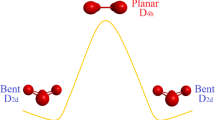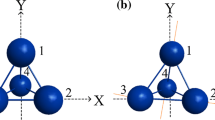Abstract
Polyanions of the aromatic origin such as dianion of benzene (C6H6 2−) are generally metastable having negative electron affinity (EA). However, the de-protonated species of these anions such as doubly-deprotonated dianions of benzene (C6H4 2−) can have higher proton affinity compared to the magnitude of the negative EA, which can trigger an intra-molecular proton transfer besides the electron auto-detachment. Such species though may exhibit resonances as in the temporary anions and cannot be treated using the conventional variational methods of the quantum mechanics. In this work, we discuss the metastability, through a nuclear-charge stabilization method, for the poly-deprotonated dianions and trianions of benzene, while exploring the intra-molecular proton-transfer reaction pathways using the conventional quantum mechanical methods, for the isomerization between the isomeric doubly-deprotonated benzene dianions, namely the ortho-, meta-, and para-C6H4 2−, as well as between the isomeric triply-deprotonated benzene trianions, namely the 1,2,3-, 1,2,4-, and 1,3,5-C6H3 3− in their singlet state. For this, the potential energy surfaces of the polyanionic species, in particular those of the doubly-deprotonated dianions, are successfully explored through an automated and systematic search performed using the global reaction route mapping method. The computations performed at the levels of the MP2, DFT with and without dispersion, and CCSD(T) theories, identified elusive reaction pathways for the isomerization between the anionic species of the poly-deprotonated benzene. Notably, a single-step isomerization between the ortho- and para-C6H4 2− dianions is observed to proceed via a direct 1, 3-proton shift in an unconventional transition state involving a puckered benzene ring in a nearly half-boat conformation. However, for the isomerization between C6H3 3− benzene trianions, the present work was able to reveal pathway only between 1,2,4-C6H3 3− and 1,3,5-C6H3 3− trianions, indicating the problems like variational collapse inherent with the conventional methods while dealing with the molecular polyanions. However, the lifetime of the metastable molecular ions investigated in this work is estimated to be of the order of only a few femtoseconds, an order of magnitude higher than the proton-transfer rate along the proposed isomerization pathways, but this study is able to provide valuable insights into the mechanism of proton transfer in the presence of a competing electron auto-detachment process.














Similar content being viewed by others
References
Vikas, Sangwan P (2014) Role of electron correlation in the polydeprotonation of benzene to form trianions. J Phys Org Chem 27:565–582
Jordan KD, Burrow PD (1987) Temporary anion states of polyatomic hydrocarbons. Chem Rev 87:557–588
Simons J (2008) Molecular anions. J Phys Chem A 112:6401–6511
Falcetta MF, DiFalco LA, Ackerman DS, Barlow JC, Jordan KD (2014) Assessment of various electronic structure methods for characterizing temporary anion states: application to the ground state anions of N2, C2H2, C2H4, and C6H6. J Phys Chem A 118:7489–7497
Jordan KD, Voora VK, Simons J (2014) Negative electron affinities from conventional electronic structure methods. Theor Chem Acc 133:1445(1)–1445(15)
Hill RN, Krauthauser C (1994) A solution to the problem of variational collapse for the one-particle dirac equation. Phys Rev Lett 27:2151–2154
Wang XB, Ding CF, Wang LS (1999) Electron tunneling through the repulsive Coulomb barrier in photodetachment of multiply charged anions. Chem Phys Lett 307:391–396
Dreuw A, Cederbaum LS (2000) Nature of the repulsive Coulomb barrier in multiply charged negative ions. Phys Rev A 63:012501
Simons J, Skurski P, Barrios R (2000) Repulsive Coulomb barriers in compact stable and metastable multiply charged anions. J Am Chem Soc 122:11893–11899
Schlegel HB (2003) Exploring potential energy surfaces for chemical reactions: an overview of some practical methods. J Comput Chem 24:1514–1527
Zhang F, Parker D, Kim KS, Kaiser RI, Mebel AM (2011) On the formation of ortho-Benzyne (o-C6H4) under single collision conditions and its role in interstellar chemistry. Astrophys J 728:141
Landera A, Krishtal SP, Kislov VV, Mebel AM, Kaiser RI (2008) Theoretical study of the C6H3 potential energy surface and rate constants and product branching ratios of the C2H(2Σ+)+C4H2(1Σg+) and C4H(2Σ+)+C2H2(1Σg+) reactions. J Chem Phys 128:214301
Ohno K, Maeda S (2004) A scaled hypersphere search method for the topography of reaction pathways on the potential energy surface. Chem Phys Lett 384:277–282
Maeda S, Ohno K (2005) Global mapping of equilibrium and transition structures on potential energy surfaces by the scaled hypersphere search method: applications to ab Initio surfaces of formaldehyde and propyne molecules. J Phys Chem A 109:5742–5753
Ohno K, Maeda S (2006) Global reaction route mapping on potential energy surfaces of formaldehyde, formic acid, and their metal substituted analogues. J Phys Chem A 110:8933–8941
Maeda S, Ohno K, Morokuma K (2009) Automated global mapping of minimum energy points on seams of crossing by the anharmonic downward distortion following method: a case study on H2CO. J Phys Chem A 113:1704–1710
Vikas, Kaur G (2013) Global reaction route mapping of isomerization pathways of exotic C6H molecular species. J Chem Phys 139:224311 (Erratum: J Chem Phys (2014) 141:039901)
Kaur G, Vikas (2014) On the mechanism of intramolecular nitrogen-atom hopping in the carbon chain of C6N radical: a plausible 3c–4e crossover \(\hat{\pi}\) long-bond. J Comp Chem 35:1568–1576
Kaur G, Vikas (2015) Mechanisms for D-L interconversion in serine. Tet Lett 56:142–145
Kaur R, Vikas (2015) Mechanisms for the inversion of chirality: global reaction route mapping of stereochemical pathways in a probable chiral extraterrestrial molecule, 2-Aminopropionitrile. J Chem Phys 142:074307
Kaur G, Vikas (2014) Exploring water catalysis in the reaction of thioformic acid with hydroxyl radical: a global reaction route mapping perspective. J Phys Chem A 118:4019–4029
Nestmann B, Peyerimhoff SD (1985) Calculation of the discrete component of resonance states in negative ions by variation of nuclear charges. J Phys B At Mol Phys 18:615–626
Nestmann B, Peyerimhoff SD (1985) CI method for determining the location and width of resonances in electron-molecule collision processes. J Phys B 18:4309–4319
Cheng HY, Chen CW, Chang JT, Shih CC (2011) Application of the stabilization method to temporary anion states of CH3CN, CH3NC, CH3SCN and CH3NCS in density functional theory with asymptotically corrected potentials. J Phys Chem A 115:84–93
Feuerbacher S, Sommerfeld T, Cederbaum LS (2004) Extrapolating bound state data of anions into the metastable domain. J Chem Phys 121:6628–6633
Jensen F (2007) Introduction to computational chemistry, 2nd edn. Wiley, Chichester
Cremer D (2001) Density functional theory: coverage of dynamic and non-dynamic electron correlation effects. Mol Phys 99:1899–1940
Parr RG, Yang W (1989) Density functional theory of atoms and molecules. Oxford University Press, New York
Koch W, Holthausen MC (2000) A chemist guide to density functional theory. Wiley, Weinheim
Chai JD, Head-Gordon M (2008) Long-range corrected hybrid functional with damped atom-atom dispersion corrections. Phys Chem Chem Phys 10:6615–6620
Lee C, Yang W, Parr RG (1988) Development of the Colle-Salvetti correlation-energy formula into a functional of the electron density. Phys Rev B 37:785–789
Becke AD (1993) Density-functional thermochemistry. III. The role of exact exchange. J Chem Phys 98:5648–5652
Simons J (1973) Theory of electron affinities of small molecule. J Chem Phys 58:4899–4907
Ehara M, Sommerfeld T (2012) CAP/SAC-CI method for calculating resonance states of metastable anions. Chem Phys Lett 537:107–112
Fukui K (1981) The path of chemical reactions: the IRC approach. Acc Chem Res 14:363–368
Page M, Mclver JW (1988) On evaluating the reaction path Hamiltonian. J Chem Phys 88:922–935
Gonzalez C, Schlegel HBJ (1989) An improved algorithm for reaction path following. J Chem Phys 90:2154–2161
Gonzalez C, Schlegel HBJ (1990) Reaction path following in mass-weighted internal coordinates. J Chem Phys 94:5523–5527
Purvis GD III, Bartlett RJ (1982) A full coupled-cluster singles and doubles model: the inclusion of disconnected triples. J Chem Phys 76:1910–1918
Scuseria GE, Janssen CL, Schaefer HF III (1988) An efficient reformulation of the closed-shell coupled cluster single and double excitation (CCSD) equations. J Chem Phys 89:7382–7387
Frisch MJ, Trucks GW, Schlegel HB, Scuseria GE, Robb MA, Cheeseman JR, Jr. Montgomery JA, Vreven T, Kudin KN, Burant JC, Millam JM, Iyengar SS, Tomasi J, Barone V, Mennucci B, Cossi M, Scalmani G, Rega N, Petersson GA, Nakatsuji H, Hada M, Ehara M, Toyota K, Fukuda R, Hasegawa J, Ishida M, Nakajima T, Honda Y, Kitao O, Nakai H, Klene M, Li X, Knox JE, Hratchian HP, Cross JB, Adamo C, Jaramillo J, Gomperts R, Stratmann RE, Yazyev O, Austin AJ, Cammi R, Pomelli C, Ochterski JW, Ayala PY, Morokuma K, Voth GA, Salvador P, Dannenberg JJ, Zakrzewski VG, Dapprich S, Daniels AD, Strain MC, Farkas O, Malick DK, Rabuck AD, Raghavachari K, Foresman JB, Ortiz JV, Cui Q, Baboul AG, Clifford S, Cioslowski J, Stefanov BB, Liu G, Liashenko A, Piskorz P, Komaromi I, Martin RL, Fox DJ, Keith T, Al-Laham MA, Peng CY, Nanayakkara A, Challacombe M, Gill PMW, Johnson B, Chen W, Wong MW, Gonzalez C, Pople JA (2004) GAUSSIAN 03, Revision E.01, Gaussian, Inc.: Wallingford, CT
Frisch MJ, Trucks GW, Schlegel HB, Scuseria GE, Robb MA, Cheeseman JR, Scalmani G, Barone V, Mennucci B, Petersson GA, Nakatsuji H, Caricato M, Li X, Hratchian HP, Izmaylov AF, Bloino J, Zheng G, Sonnenberg JL, Hada M, Ehara M, Toyota K, Fukuda R, Hasegawa J, Ishida M, Nakajima T, Honda Y, Kitao O, Nakai H, Vreven T, Montgomery JA Jr, Peralta JE, Ogliaro F, Bearpark M, Heyd JJ, Brothers E, Kudin KN, Staroverov VN, Kobayashi R, Normand J, Raghavachari K, Rendell A, Burant JC, Iyengar SS, Tomasi J, Cossi M, Rega N, Millam JM, Klene M, Knox JE, Cross JB, Bakken V, Adamo C, Jaramillo J, Gomperts R, Stratmann RE, Yazyev O, Austin AJ, Cammi R, Pomelli C, Ochterski JW, Martin RL, Morokuma K, Zakrzewski VG, Voth GA, Salvador P, Dannenberg JJ, Dapprich S, Daniels AD, Farkas O, Foresman JB, Ortiz JV, Cioslowski J, Fox DJ (2013) Gaussian 09, Revision D.01, Gaussian, Inc.: Wallingford, CT
Cheng HY, Chen CW (2011) Energy and lifetime of temporary anion states of uracil by stabilization method. J Phys Chem A 115:10113–10121
Whitehead A, Barrios R, Simons J (2002) Stabilization calculation of the energy and lifetime of metastable SO4 2−. J Chem Phys 116:2848–2851
Mauracher A, Denifl S, Edtbauer A, Hager M, Probst M (2010) Metastable anions of dinitrobenzene: resonances for electron attachment and kinetic energy release. J Chem Phys 133:244302
Bachrach SM, Hare M, Kass SR (1998) Alkali metal salts of dianions: a theoretical and experimental study of (C6H4)2−M+ (M = Li and Na). J Am Chem Soc 120:12646–12649
Acknowledgments
The authors are grateful to Prof. Koichi Ohno for providing GRRM program and to Dr. Neetu Goel and Department of Chemistry, Panjab University, Chandigarh, for providing other computational software and resources.
Author information
Authors and Affiliations
Corresponding author
Electronic supplementary material
Below is the link to the electronic supplementary material.
Rights and permissions
About this article
Cite this article
Sangwan, P., Vikas Exploring the metastability and the pathways for polyanionic isomerization in the dianions and trianions of doubly- and triply-deprotonated benzene. Theor Chem Acc 134, 99 (2015). https://doi.org/10.1007/s00214-015-1695-6
Received:
Accepted:
Published:
DOI: https://doi.org/10.1007/s00214-015-1695-6




